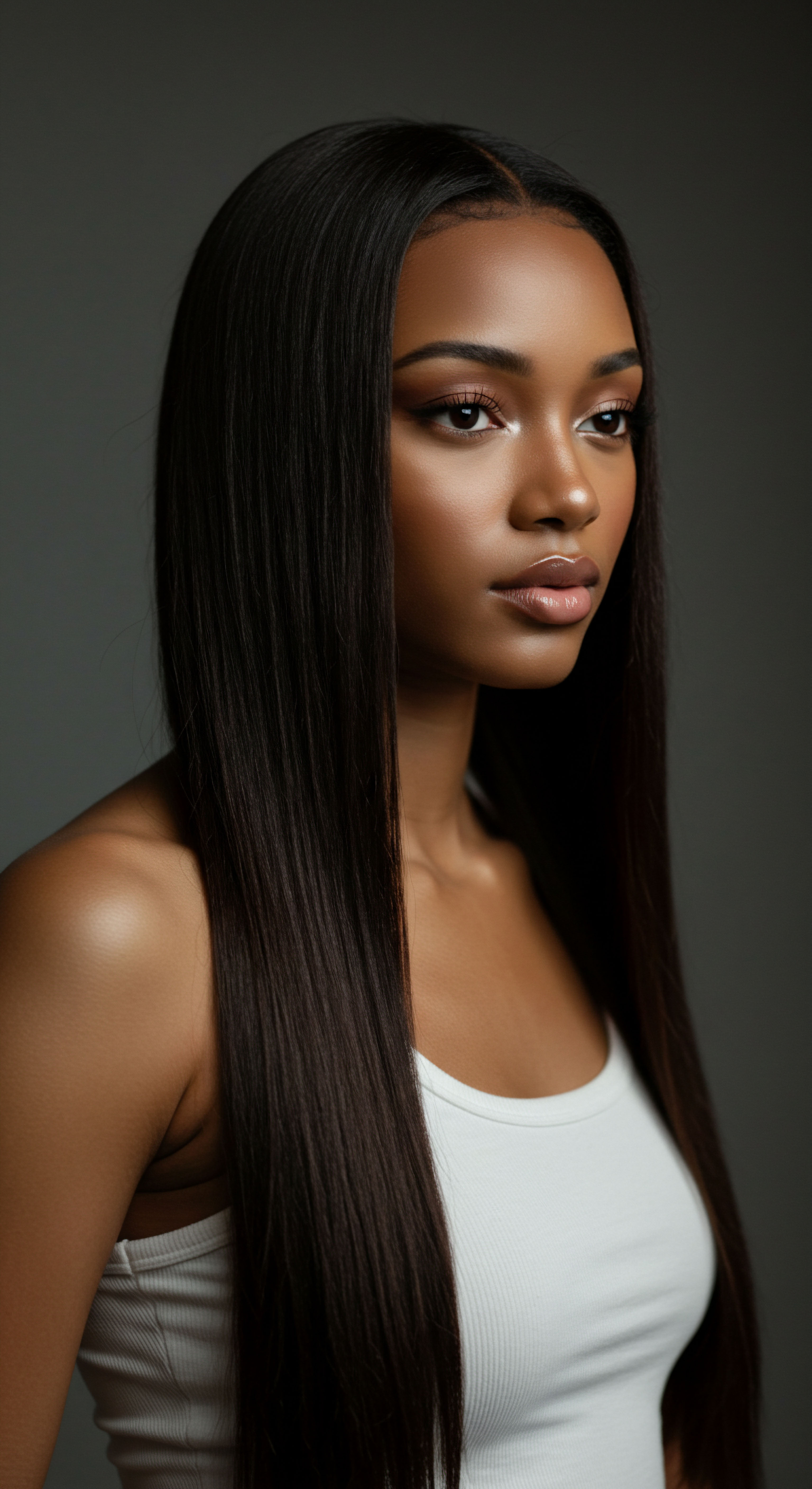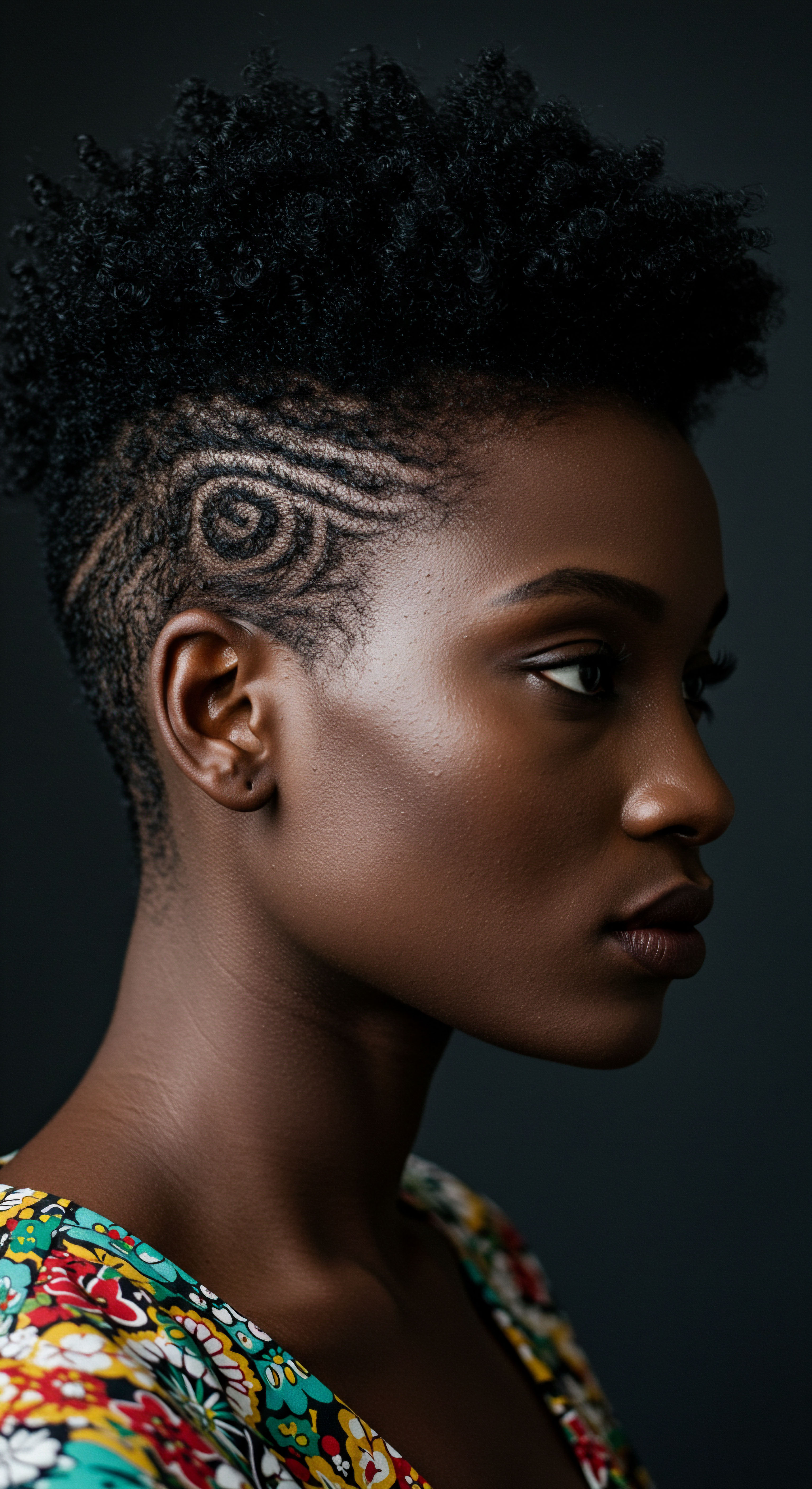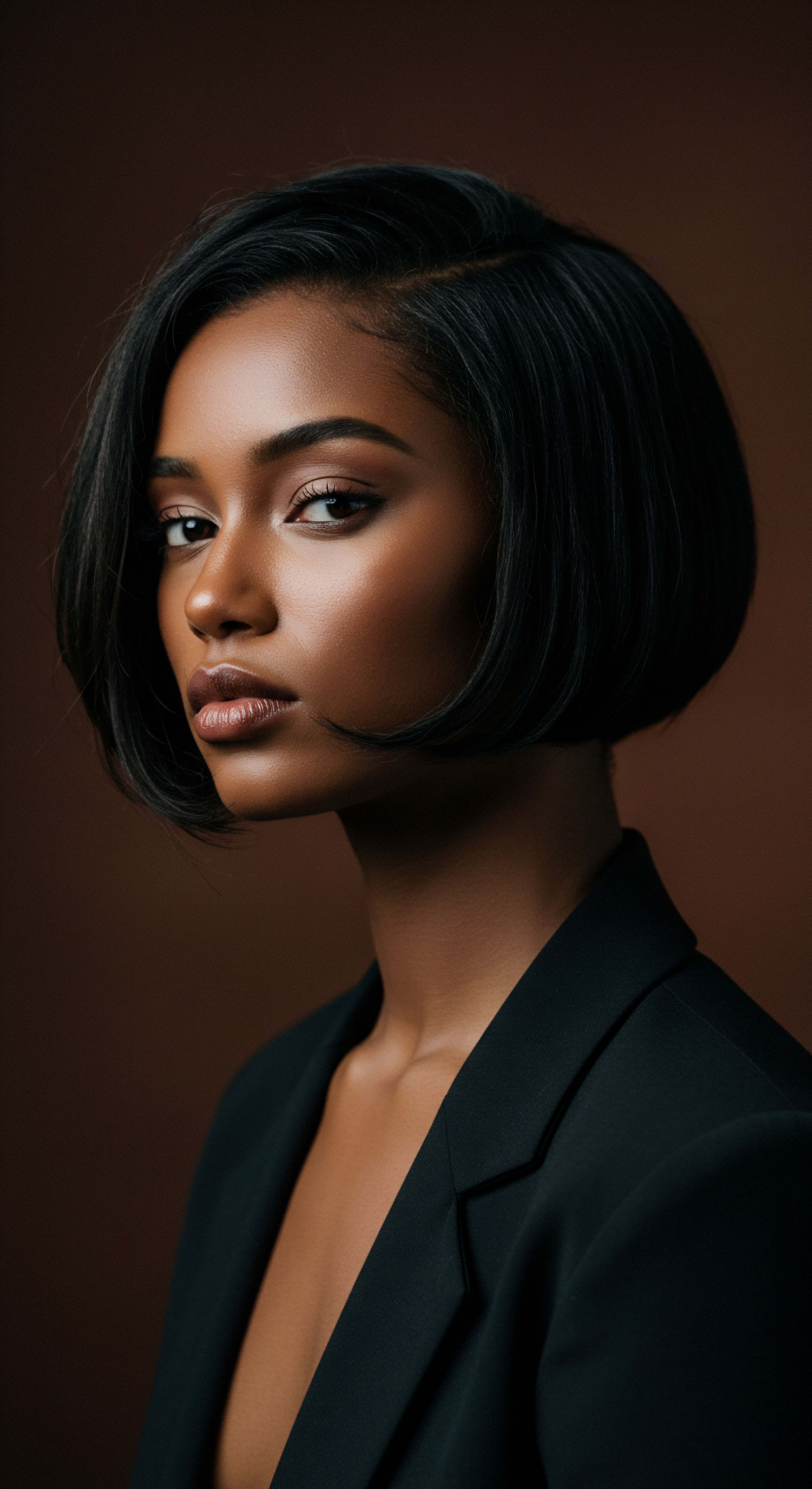
Roots
The quiet rustle of fabric, a soft embrace around one’s hair, holds a history far richer than a fleeting trend. From ancient civilizations to contemporary comfort, the act of covering one’s hair has been a persistent human practice, imbued with layers of meaning, from the deeply practical to the profoundly symbolic. This continuum, stretching across millennia, provides the foundational understanding for why a modern silk bonnet feels so inherently right for textured hair. It speaks to an ancestral knowing, a gentle wisdom passed down through generations about safeguarding one’s strands.
Across diverse cultures and epochs, head coverings served a spectrum of purposes. In ancient African, Middle Eastern, and Asian societies, dating back as early as 3000 BCE, headwraps provided crucial protection against harsh environmental elements like sun, dust, and wind in arid climates. Egyptian hieroglyphs reveal nobility adorned with elaborate head coverings, suggesting an early association with social standing.
West African traditions, evidenced archaeologically from the Kingdom of Ghana (300-1200 CE), show wraps made from locally sourced textiles, often featuring patterns specific to the region. These were not merely decorative; they were a shield, a practical necessity in daily life.

What Ancient Civilizations Wore on Their Heads?
The earliest forms of head coverings were born of necessity, shielding delicate hair and scalps from the sun’s relentless rays and abrasive winds. In ancient Egypt, fine linen fabrics draped the head, sometimes embellished with gold or precious materials to signify wealth and status. Roman and Greek women of higher social standing often wore veils, such as the Greek “kredemnon” or the Roman “flammeum,” not only for modesty or religious piety but also as a marker of their position within society. These coverings offered a tangible barrier between the hair and external stressors, an early acknowledgment of hair’s vulnerability.
Beyond mere environmental protection, hair coverings became visual markers of identity. In many African societies, the specific style of a wrap could indicate a person’s marital status, age, wealth, or religious affiliation. The Yoruba and Igbo women in Nigeria, for example, wore the elaborate Gele for celebrations, with the complexity of the wrap often reflecting status.
Similarly, Sikh turbans, or Dastar, represent equality, honor, and self-respect, with the careful wrapping process holding spiritual significance. These traditions underscore a deeply ingrained understanding that hair, and its covering, communicates volumes without uttering a word.
Hair coverings, from ancient headwraps to modern bonnets, have always served as a silent language, communicating status, belief, and practical care across diverse cultures.

How Did Hair Coverings Protect Hair in the Past?
The protective function of historical hair coverings extended beyond environmental shielding. They acted as physical barriers, keeping hair contained and preventing tangles and breakage that could occur during daily activities. For enslaved Black women in the United States, headwraps, or Tignons, initially imposed as symbols of subservience by laws in regions like Louisiana, were transformed into powerful declarations of dignity and cultural pride through the use of luxurious fabrics and elaborate styles.
These coverings helped preserve hair health under arduous conditions, absorbing sweat and keeping braided styles intact. This adaptive spirit, turning a tool of oppression into one of self-expression and hair preservation, highlights the enduring practical utility of hair coverings.
Consider the intricate practice of African Hair Threading, a traditional hairstyling technique prevalent in West and Central Africa since at least the 15th century. This method involves wrapping sections of natural hair tightly with threads, often wool or cotton. This meticulous art form, passed down through generations, acts as a protective style, safeguarding hair from breakage and promoting healthy growth by minimizing manipulation and external exposure. The longevity of such practices points to an intuitive, generational understanding of hair care that prioritized preservation through covering and securing.
- Headwraps ❉ Provided environmental protection against sun, dust, and wind in ancient societies.
- Veils ❉ Used by upper classes in ancient Greece and Rome, signifying status and modesty.
- African Hair Threading ❉ Protected hair from breakage and promoted growth by reducing manipulation.

Ritual
Stepping from the quiet wisdom of ancient practices into the rhythm of daily life, we discover that hair care has always been a ritual, a series of intentional actions designed to preserve and adorn. The modern silk bonnet, with its gentle caress, stands as a direct descendant of these long-held traditions, a contemporary iteration of a protective practice that has evolved with understanding and innovation. It acknowledges the simple truth that what we do for our hair when the world sleeps, or when we step out, profoundly impacts its vitality.
The connection between historical hair coverings and the silk bonnet of today is not merely aesthetic; it is rooted in a shared objective ❉ protection. Historically, head coverings were not just for public display or religious observance; they served a fundamental role in maintaining hair health. Rural women in parts of Africa, for example, used head wraps as protective clothing to shield their hair from dust and dirt during chores.
Similarly, during World War II, women working in factories wore kerchiefs to keep their hair out of machinery and prevent damage. These practical applications laid the groundwork for our contemporary understanding of hair protection.

How Do Modern Silk Bonnets Continue Ancient Protective Practices?
The modern silk bonnet carries forward the legacy of these protective traditions, adapting ancient wisdom to contemporary needs. Its primary function is to create a serene environment for hair, particularly while sleeping. This aligns directly with historical uses of head coverings during rest.
In some African cultures, head ties were worn during sleep to protect hair. The smooth surface of silk is a significant upgrade from rougher fabrics like cotton, which can absorb natural oils and create friction, leading to dryness, tangles, and breakage.
The science behind silk’s efficacy is compelling. Silk is a natural protein fiber, and its smooth surface significantly reduces mechanical stress on hair. A study published in the Journal of Cosmetic Dermatology indicated that sleeping on a silk surface can reduce hair friction by up to 43%. This reduction in friction helps maintain the integrity of the hair cuticle, the outermost protective layer of the hair shaft.
When cuticles lie flat, hair retains moisture more effectively, appears smoother, and is less prone to frizz and breakage. This is especially important for textured hair, which is often more susceptible to friction damage due to its coil pattern.
| Property Surface Texture |
| Silk Smooth, low friction |
| Cotton Rough, high friction |
| Property Moisture Absorption |
| Silk Less absorbent, retains hair's natural oils |
| Cotton Highly absorbent, strips hair of moisture |
| Property Hair Breakage |
| Silk Minimizes breakage and tangling |
| Cotton Increases breakage and split ends |
| Property Frizz Reduction |
| Silk Reduces friction-induced frizz |
| Cotton Contributes to frizz and static |
| Property Silk offers superior hair protection by minimizing friction and preserving moisture compared to cotton. |

What Are the Practical Benefits of Using a Silk Bonnet?
The practical benefits of incorporating a silk bonnet into a hair care regimen are numerous, extending the life of styles and contributing to overall hair health. For individuals with textured hair, maintaining moisture is a constant pursuit, and silk’s non-absorbent nature helps to keep essential oils and hydration within the hair shaft. This contrasts sharply with cotton, which acts like a sponge, drawing moisture away from the hair.
Beyond moisture retention, the bonnet acts as a physical shield. It prevents hair from snagging on bedding, reduces friction from tossing and turning during sleep, and keeps hairstyles intact for longer. This means less need for daily restyling, which in turn reduces manipulation and potential heat damage, contributing to healthier hair growth over time.
A silk bonnet acts as a nighttime cocoon, preserving hair’s natural moisture and reducing friction for healthier strands.
- Moisture Retention ❉ Silk’s less absorbent nature helps hair hold onto its natural oils and applied products.
- Friction Reduction ❉ The smooth surface lessens mechanical stress, preventing breakage and split ends.
- Style Preservation ❉ Keeps hairstyles intact overnight, minimizing the need for frequent restyling.
The choice of material is paramount in this protective ritual. While satin offers a more affordable alternative with similar smooth properties, true silk, with its natural protein structure and inherent benefits, stands as the optimal choice for those seeking the highest level of hair care. This deliberate selection of materials for hair coverings echoes ancient practices where specific fabrics or adornments were chosen for their perceived properties and symbolic value. The silk bonnet, then, is not merely a modern accessory; it is a continuation of a time-honored ritual, refined by scientific understanding and a deep respect for hair’s delicate nature.

Relay
To truly comprehend the contemporary silk bonnet, one must extend beyond its immediate function and consider the profound historical and cultural currents that inform its presence. It is a product of evolving knowledge, a testament to human ingenuity in adapting protective practices, and a symbol imbued with layers of meaning that stretch back to ancient times. This section will delve into the deeper connections, examining the interplay of historical contexts, scientific insights, and cultural reclamation that culminate in the modern protective hair covering.
The journey from ancient headwraps to the silk bonnet reveals a continuous human endeavor to protect and adorn hair, often intertwined with social commentary and personal identity. Hair, as a biological fiber, is susceptible to mechanical damage, particularly friction, which can lift and chip its outermost protective layer, the cuticle. This vulnerability has been implicitly understood for centuries, leading to various protective coverings.

How Does Hair Porosity Relate to Protective Coverings?
The effectiveness of protective coverings, including silk bonnets, is deeply tied to the science of hair porosity. Hair Porosity refers to how well your hair absorbs and retains moisture, determined by the state of its cuticle layer.
- Low Porosity Hair ❉ This hair type has a tightly sealed cuticle, making it difficult for moisture to penetrate. While it retains moisture once absorbed, products can sit on the surface, leading to buildup. For this hair, protective coverings help seal in moisture after it has been properly introduced, often with the aid of heat.
- Medium Porosity Hair ❉ With a slightly raised cuticle, this hair type absorbs and retains moisture optimally, generally being healthy and manageable. Protective coverings help maintain this balance and prevent external damage.
- High Porosity Hair ❉ This hair type has a lifted or compromised cuticle, allowing moisture to enter and exit easily, leading to dryness, frizz, and breakage. This is where protective coverings, especially silk, become paramount. They create a barrier that minimizes friction, which further damages the already open cuticles, and help to seal in moisture, which is critical for this hair type.
The choice of a smooth material like silk directly addresses the needs of porous hair by minimizing friction that can exacerbate cuticle damage. Rough fabrics, like cotton, can cause significant friction, leading to further lifting of the cuticle and increased moisture loss, particularly for high porosity hair.

What Are the Sociocultural Dimensions of Hair Coverings?
Beyond the scientific benefits, the sociocultural dimensions of hair coverings provide a rich backdrop for understanding the silk bonnet. Hair has long been a potent symbol of identity, status, and spirituality across cultures. Its covering, therefore, often carries profound meaning.
Consider the historical context of hair coverings within the African diaspora. During the transatlantic slave trade, Africans brought their traditions of hair wrapping to the Americas. Initially, these coverings became tools of control. For example, in late 18th-century Louisiana, the Tignon Laws mandated that free Black women cover their hair to signify a lower social status.
Yet, these women defiantly transformed the tignon into a fashion statement, using luxurious fabrics and elaborate styles to assert their dignity and cultural identity. This act of reclamation, turning an oppressive mandate into a symbol of resilience and beauty, is a powerful historical precedent for the modern silk bonnet. The bonnet, in this light, can be seen as a contemporary extension of this defiant self-preservation and cultural pride.
The connection between hair coverings and identity is not unique to the African diaspora. In medieval Europe, the Roman Catholic Church decreed that women cover their heads, leading to elaborate headdresses that also denoted class and marital status. Similarly, in early Jewish societies, married women were required to cover their hair, seen as a private asset not to be viewed in public. These historical practices demonstrate a universal human tendency to use hair coverings as a means of expressing social norms, religious devotion, and personal standing.
A significant study on hair friction and its impact on hair health, published in the Journal of Cosmetic Dermatology, revealed that a smooth surface can reduce hair friction by a substantial margin. Specifically, the study highlighted that sleeping on a silk surface can reduce hair friction by up to 43% compared to cotton. This quantitative data underscores the tangible protective advantage of silk and provides a scientific basis for the widespread anecdotal evidence supporting its use for hair preservation. This reduction in mechanical stress translates directly to less cuticle damage, fewer tangles, and a noticeable decrease in breakage, particularly for delicate or textured hair types which are more prone to such issues.
The modern silk bonnet, therefore, is not merely a luxurious accessory. It is a continuation of an ancient protective tradition, informed by a nuanced understanding of hair biology and a profound history of cultural expression and resistance. Its popularity, particularly within textured hair communities, is a testament to its effectiveness in promoting hair health and its resonance as a symbol of self-care and cultural affirmation.

Reflection
The journey from ancient head coverings to the modern silk bonnet reveals more than just an evolution of materials or styles; it speaks to a timeless human understanding of hair as a cherished aspect of self, deserving of care and protection. From the practicalities of shielding against the elements to the complex layers of social, spiritual, and personal expression, hair coverings have consistently served as a quiet, yet powerful, testament to human connection with our crowns. The silk bonnet, in its gentle simplicity, carries forward this deep heritage, offering a contemporary sanctuary for strands. It is a reminder that the wisdom of generations past, refined by modern understanding, continues to shape our daily rituals, inviting us to approach our hair not merely as a biological structure, but as a living legacy.

References
- Afro Street. (2025-05-07). The Cultural Significance of Headwraps & How to Wear Them ❉ Embracing Heritage and Style.
- Wilderness Safaris. (2015-01-25). The history & meaning of head wraps across Africa.
- Obé Headwear. (2024-08-05). Significance of headwraps | Hair care.
- The Chic Icon. (2024-10-30). Secret Benefits of Silk for Hair and Skin.
- JD Institute of Fashion Technology. (2021-06-23). HEADWRAPS ❉ HISTORY AND EVOLUTION.
- Silkbiotic. The Scientifically Proven Benefits of Silk for Skin and Hair.
- Esme Luxury. (2024-08-06). Silk Hair Wraps in Different Cultures ❉ A Global Perspective.
- Girl of a different Era. (2020-08-30). The History of Women’s Head Covering.
- Eratus Creations. (2023-06-02). Healthy properties of silk.
- LuxCare. The Evolution of Headscarves ❉ from ancient Egypt to the red carpet.
- American Academy of Dermatology. (2023-11-30). What Every Dermatologist Must Know About the History of Black Hair.
- Stenn, K. (2016). Hair ❉ A Human History. Pegasus Books.
- She Reads. (2022-11-18). 10 Books On the Evolution of Black Culture Through Hair.
- The Natural Hair Advocate. (2016-05-31). Wrap it Up ❉ A Tribute to the Head Tie.
- Crownned. (2023-04-08). Headwrap vs. Turban ❉ What’s the Difference?
- scooms. (2024-04-22). Are silk pillowcases good for hair?
- Slipssy. (2025-04-16). Slipssy’s First-Night Effect ❉ How Reducing Friction Transforms Your Hair Overnight.
- Biddle-Perry, G. (2022). A Cultural History of Hair in the Modern Age. Bloomsbury Advanced.
- The Private Party Podcast. (2025-02-18). The History and Symbolism of Hair Wrapping Across the African Diaspora.
- Miyé. (2024-07-30). What are the benefits of silk?
- Central Oregon Community College. Encyclopedia of Hair ❉ A Cultural History.
- sonson. (2021-04-24). The History of Headwraps and Black Culture.
- JM. (2024-12-04). Hair Wraps and Braids ❉ Styling Guide for All Textures.
- Lab Muffin Beauty Science. (2020-10-18). Silk for Skincare and Haircare.
- The Austin Hair Research Center. (2025-05-14). I stopped using cotton pillowcases and reduced hair breakage by 43% (what my hairstylist noticed after 2 weeks).
- Helix Hair Labs. (2023-05-26). IS HAIR BREAKAGE HAPPENING WHILE YOU SLEEP?
- Wikipedia. African hair threading.
- Clinikally. (2024-11-26). Understanding Low Porosity Hair ❉ Best Tips for Care.
- Smithsonian National Museum of African American History and Culture. (2023-08-16). Strands of Inspiration ❉ Exploring Black Identities through Hair.
- Bloomsbury Publishing. (2019-02-07). A Cultural History of Hair ❉ Volumes 1-6.
- American University. It’s Not Just Hair ❉ Historical and Cultural Considerations for an Emerging Technology.
- Solsilk. (2024-04-11). The Science Behind Silk.
- Seychelles Nation. (2022-05-21). The connection between hair and identity.
- Fabulive. Cultural Significance of Hair Through Time.
- Healthline. (2024-06-09). Hair Porosity ❉ What You Need To Know.
- Wimpole Clinic. High Porosity Hair ❉ The Definitive Guide For Porous Hair.
- Healthline. (2019-08-22). What Type of Hair Porosity Do You Have?
- Little Extra. (2023-01-25). How to Prevent Split Ends While Sleeping.
- NYSCC. (2020-11-11). An Overview on Hair Porosity.
- Helix Hair Labs. (2025-04-16). The Long-Term Effects of Slipssy ❉ Protecting Your Hair Follicles, Pres.
- Clinikally. (2023-07-25). 10 Effective Ways to Protect Your Hair While You Sleep.
- MDPI. (2023-07-19). Hair Lipid Structure ❉ Effect of Surfactants.
- Real Simple. (2023-01-09). 6 Ways to Prevent Hair Loss While Sleeping.